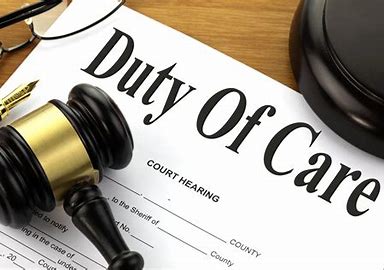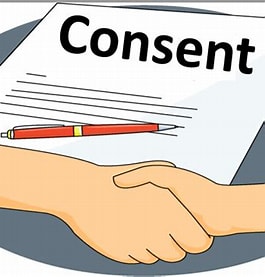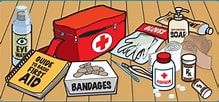2.1 Legal Issues in First Aid
Duty of Care
-
A First Aider has a responsibility to provide care correctly, carefully and to avoid harming the patient.
-
A duty of care is imposed when:
-
A First Aider freely gives assistance.
-
You are a designated First Aider in the workplace.
-
If First Aid care is provided in accordance with the recognised standards, training and skills the duty of care is satisfied

Consent
-
Consent is considered to be given if the patient agrees to be helped by the first aider
-
In emergency situations that involve children, the law allows the provider to take ‘reasonable action’ without formal consent from a parent or guardian.
-
A person has a right to refuse consent for treatment
-
If a person is unconscious or does not actively refuse consent then “implied” consent is said to exist

Negligence
-
No first aider has been successfully sued in Australia for treatment given in the capacity of volunteering to provide first aid
-
Negligence is only considered if the first aider has caused an injury
-
It must be proven that the patient is worse off because of the assistance provided than they would have been if no assistance had been given

Privacy and Confidentiality
-
At all times a patients privacy should be protected
-
Medical forms and information should only be passed onto:
-
The next level of medical care (Doctor, Paramedic etc)
-
Any management level with a “need to know” and usually this is just limited information

As a First Aider, you need to treat each casualty with respect, regardless of their injury or illness
As a First Aider you will need to always act in a professional and respectful way. Being respectful means:
Introducing yourself
Asking for the casualty’s name and using it
Asking the casualty for consent
Informing the casualty of what you are doing and why
Focus on providing care and ask the casualty to assist if they can
Being aware of cultural differences and showing sensitivity
Comfort and reassure the casualty at all times
Using a calm voice
Protecting their privacy and confidentiality
Respectful behaviour also includes culturally appropriate behaviour. A person who is culturally aware can communicate sensitively and effectively with people who have different languages, cultures, religions, genders, ethnicities, disabilities, ages and sexualities.
Cultural awareness includes:
Appropriate communication
Awareness of own body language and tone
Appropriate use of eye contact
Awareness of differences in age, gender or ethnicity
Respectful and culturally aware First Aiders build trust which leads to improved outcomes in establishing good rapport with their casualty

Limitation is a form of restriction where you provide first aid within the scope of your first aid training
The first aid you provide as a First Aider will be restricted by:
Scope of your training – this means that when giving first aid, always stay within what you know and treat a casualty to a standard of care at your level of training. For example, if you have not learnt how to use oxygen equipment you would not be able to administer oxygen to a casualty.
Your level of confidence – this means the more confident you are in providing first aid the more proficient you will be.
Your company’s policies and procedures – this means you always need to know and apply your company’s policies and procedures when providing first aid in the workplace.
Legal considerations – you should not allow the thought of liability stop you from providing lifesaving first aid! First aiders are only liable if negligence can be shown.
Ensure that you fully understand the law.


Duty of Care
-
A First Aider has a responsibility to provide care correctly, carefully and to avoid harming the patient.
-
A duty of care is imposed when:
-
A First Aider freely gives assistance.
-
You are a designated First Aider in the workplace.
-
If First Aid care is provided in accordance with the recognised standards, training and skills the duty of care is satisfied

Consent
-
Consent is considered to be given if the patient agrees to be helped by the first aider
-
In emergency situations that involve children, the law allows the provider to take ‘reasonable action’ without formal consent from a parent or guardian.
-
A person has a right to refuse consent for treatment
-
If a person is unconscious or does not actively refuse consent then “implied” consent is said to exist

Negligence
-
No first aider has been successfully sued in Australia for treatment given in the capacity of volunteering to provide first aid
-
Negligence is only considered if the first aider has caused an injury
-
It must be proven that the patient is worse off because of the assistance provided than they would have been if no assistance had been given

Privacy and Confidentiality
-
At all times a patients privacy should be protected
-
Medical forms and information should only be passed onto:
-
The next level of medical care (Doctor, Paramedic etc)
-
Any management level with a “need to know” and usually this is just limited information

As a First Aider, you need to treat each casualty with respect, regardless of their injury or illness
As a First Aider you will need to always act in a professional and respectful way. Being respectful means:
Introducing yourself
Asking for the casualty’s name and using it
Asking the casualty for consent
Informing the casualty of what you are doing and why
Focus on providing care and ask the casualty to assist if they can
Being aware of cultural differences and showing sensitivity
Comfort and reassure the casualty at all times
Using a calm voice
Protecting their privacy and confidentiality
Respectful behaviour also includes culturally appropriate behaviour. A person who is culturally aware can communicate sensitively and effectively with people who have different languages, cultures, religions, genders, ethnicities, disabilities, ages and sexualities.
Cultural awareness includes:
Appropriate communication
Awareness of own body language and tone
Appropriate use of eye contact
Awareness of differences in age, gender or ethnicity
Respectful and culturally aware First Aiders build trust which leads to improved outcomes in establishing good rapport with their casualty

Limitation is a form of restriction where you provide first aid within the scope of your first aid training
The first aid you provide as a First Aider will be restricted by:
Scope of your training – this means that when giving first aid, always stay within what you know and treat a casualty to a standard of care at your level of training. For example, if you have not learnt how to use oxygen equipment you would not be able to administer oxygen to a casualty.
Your level of confidence – this means the more confident you are in providing first aid the more proficient you will be.
Your company’s policies and procedures – this means you always need to know and apply your company’s policies and procedures when providing first aid in the workplace.
Legal considerations – you should not allow the thought of liability stop you from providing lifesaving first aid! First aiders are only liable if negligence can be shown.
Ensure that you fully understand the law.


